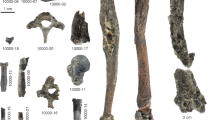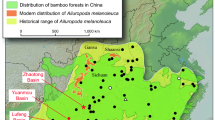Abstract
KANGAROOS (family Macropodidae, order Marsupialia) are the only known group of large Australian herbivorous marsupials ever to have evolved major cursorial specialisations. During fast locomotion macropodids progress by a ricochet (bipedal saltation) involving a series of rebounds in which the two hind feet strike the ground at the same moment or practically synchronously and the forefeet not at all1. In macropodids the axis of the hind foot is through digit IV which is unique among large cursorial mammals; perissodactyls and most rodents have the axis through digit III, while in artiodactyls, carnivores and leporids it lies between digit III and IV2. These differences are the result of preadaptive complexes in the immediate ancestors of these groups.
This is a preview of subscription content, access via your institution
Access options
Subscribe to this journal
Receive 51 print issues and online access
$199.00 per year
only $3.90 per issue
Buy this article
- Purchase on Springer Link
- Instant access to full article PDF
Prices may be subject to local taxes which are calculated during checkout
Similar content being viewed by others
References
Hatt, R. T., Bull. Am. Mus. nat. Hist., 63, 602 (1932).
Lull, R. S., Am. Nat., 38, 2 (1904).
Haines, R. W., Q. Rev. Biol., 33, 20 (1958).
Matthew, W. D., Trans. Am. phil. Soc., 30, 315 (1937).
Schaeffer, B., Am. Mus. Novit., 1356, 4 (1947).
Huxley, T. H., Proc. zool. Soc. Lond., 1880 (1880).
Dollo, L., Trav. Stn. zool. Wimereux, 7 (1899).
Bensley, B. A., Am. Nat., 35, (1901).
Bensley, B. A., Trans. Linn. Soc. Lond., 9, (1903).
Müller, R. J., Z. Morph. Ökol. Tiere, 17, (1929).
Ride, W. D. L., in The Evolution of Living Organisms (edit. by Leeper, G. W.) 281 (Melbourne University Press, 1962).
Goodrich, E. S., Proc. zool. Soc. Lond., 1, 177 (1935).
Wood-Jones, F., The Mammals of South Australia 134 (Adelaide, Government Print., 1923–25).
Simpson, G. G., Bull. Mus. comp. Zool. Harv., 139, 40 (1970).
Marshall, L. G., Proc. R. Soc. Vict., 85, 55 (1972).
Tate, G. H. H., Bull. Am. Mus. nat. Hist., 92, 317 (1948).
Kirsh, J. A. W., Nature, 217, (1968).
Marshall, L. G., Aust. Mammal., 1, 67 (1972).
Foster, A., Archs Anat. Histol. Embryol., 5, (1926).
Foster, A., Archs Anat. Histol. Embryol., 10, (1928).
Stains, H. J., J. Mammal., 40, 400 (1959).
Howell, A. B., Speed in Animals, 247 (Hafner Publishing Co., New York, 1944).
Author information
Authors and Affiliations
Rights and permissions
About this article
Cite this article
MARSHALL, L. Why kangaroos hop. Nature 248, 174–176 (1974). https://doi.org/10.1038/248174a0
Received:
Revised:
Issue Date:
DOI: https://doi.org/10.1038/248174a0
Comments
By submitting a comment you agree to abide by our Terms and Community Guidelines. If you find something abusive or that does not comply with our terms or guidelines please flag it as inappropriate.



